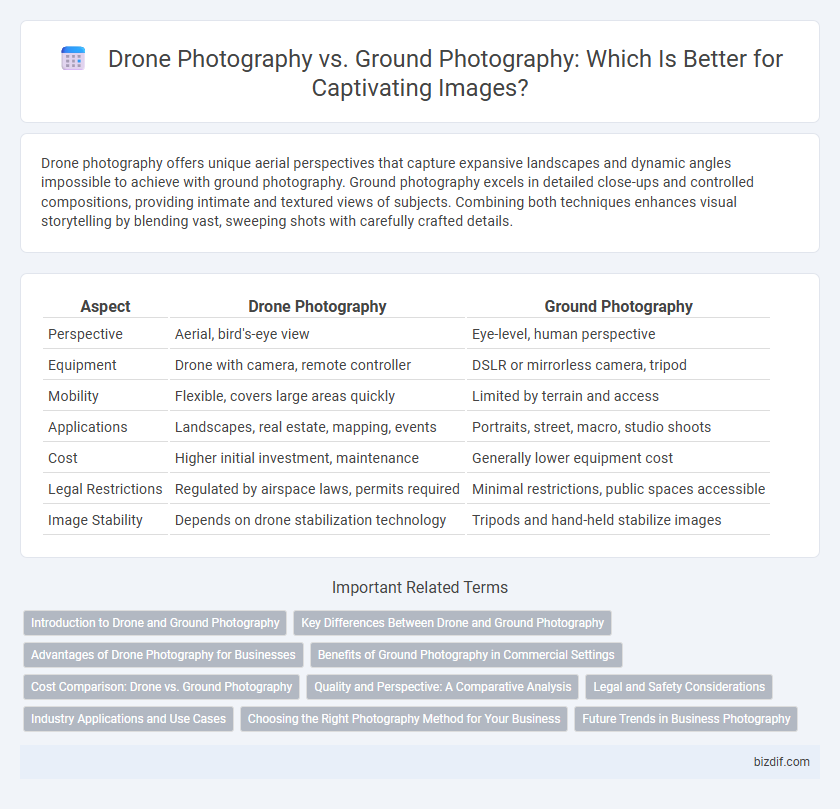Drone photography offers unique aerial perspectives that capture expansive landscapes and dynamic angles impossible to achieve with ground photography. Ground photography excels in detailed close-ups and controlled compositions, providing intimate and textured views of subjects. Combining both techniques enhances visual storytelling by blending vast, sweeping shots with carefully crafted details.
Table of Comparison
| Aspect | Drone Photography | Ground Photography |
|---|---|---|
| Perspective | Aerial, bird's-eye view | Eye-level, human perspective |
| Equipment | Drone with camera, remote controller | DSLR or mirrorless camera, tripod |
| Mobility | Flexible, covers large areas quickly | Limited by terrain and access |
| Applications | Landscapes, real estate, mapping, events | Portraits, street, macro, studio shoots |
| Cost | Higher initial investment, maintenance | Generally lower equipment cost |
| Legal Restrictions | Regulated by airspace laws, permits required | Minimal restrictions, public spaces accessible |
| Image Stability | Depends on drone stabilization technology | Tripods and hand-held stabilize images |
Introduction to Drone and Ground Photography
Drone photography captures images and videos from aerial perspectives using unmanned aerial vehicles equipped with high-resolution cameras, enabling unique angles and expansive views impossible from the ground. Ground photography involves capturing scenes from human-level perspectives using handheld or tripod-mounted cameras, emphasizing details, textures, and direct subject interactions. Both methods offer distinct advantages: drone photography excels in landscape and architectural shots, while ground photography provides intimate, detailed storytelling opportunities.
Key Differences Between Drone and Ground Photography
Drone photography captures high-resolution aerial images and panoramic views that are impossible from the ground, offering unique perspectives for real estate, landscapes, and large-scale events. Ground photography emphasizes detailed close-ups, controlled lighting, and subject interaction, excelling in portraits, macro shots, and everyday scenes. Key differences include altitude flexibility, field of view, and equipment limitations, where drones provide expansive angles but face flight regulations, while ground cameras offer precise frame control without aerial restrictions.
Advantages of Drone Photography for Businesses
Drone photography offers businesses unique aerial perspectives that enhance marketing materials with breathtaking visuals unreachable by ground photography. It enables efficient coverage of large areas, ideal for real estate listings, construction site monitoring, and agricultural assessments. High-resolution drone images accelerate project timelines and improve data accuracy, driving informed decision-making and competitive advantage.
Benefits of Ground Photography in Commercial Settings
Ground photography in commercial settings offers unparalleled detail and precision, capturing textures and features that drones may miss due to altitude limitations. It enables controlled lighting and angles, crucial for product shots, real estate listings, and architectural documentation where clarity and accuracy impact buyer decisions. Ground photography also avoids regulatory restrictions and potential safety risks associated with drone operations, ensuring a smoother, compliant workflow.
Cost Comparison: Drone vs. Ground Photography
Drone photography often involves higher initial costs due to purchasing or renting advanced drones, maintenance, and regulatory compliance fees. Ground photography typically requires less investment, mainly limited to camera equipment and accessories, making it more cost-effective for beginners and small projects. Over time, drone photography can offer efficiency and unique perspectives that offset its upfront expenses, especially in commercial or large-scale applications.
Quality and Perspective: A Comparative Analysis
Drone photography offers unparalleled aerial perspectives, capturing expansive landscapes and unique angles impossible with ground photography. Ground photography excels in detail, texture, and controlled composition, allowing for intimate, high-resolution close-ups. Combining both methods enhances visual storytelling by leveraging drones' wide vantage points and ground shots' nuanced clarity.
Legal and Safety Considerations
Drone photography requires strict adherence to aviation regulations, including altitude limits, no-fly zones, and mandatory registration with aviation authorities like the FAA in the United States. Ground photography typically faces fewer legal restrictions but demands careful attention to property rights, privacy laws, and public safety, especially in crowded or sensitive locations. Safety considerations for drone operators include maintaining visual line of sight, avoiding hazardous weather conditions, and ensuring battery reliability to prevent crashes or injuries.
Industry Applications and Use Cases
Drone photography revolutionizes industries like real estate, agriculture, and construction by providing aerial views for site surveys, crop health monitoring, and progress tracking. Ground photography remains essential for detailed product shots, portraits, and interior inspections where close-up and controlled angle captures are required. Combining both methods enhances data collection accuracy and visual storytelling across various professional sectors.
Choosing the Right Photography Method for Your Business
Drone photography captures expansive aerial views and unique perspectives, ideal for real estate, construction, and event documentation. Ground photography excels in detailed close-ups and controlled compositions, making it suitable for portraits, product images, and intricate visual storytelling. Selecting the right method depends on your business needs, budget, and desired visual impact, with some projects benefiting from a combination of both techniques.
Future Trends in Business Photography
Drone photography is revolutionizing business photography by providing aerial perspectives that ground photography cannot achieve, enabling innovative marketing and real estate visuals. Emerging technologies such as AI-powered drones and 5G connectivity enhance real-time image processing and remote control capabilities, increasing efficiency for commercial shoots. The integration of 3D mapping and automated flight paths further pushes the boundaries, making drone photography an indispensable tool in future business imaging strategies.
Drone Photography vs Ground Photography Infographic

 bizdif.com
bizdif.com